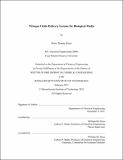Nitrogen oxide delivery systems for biological media
Author(s)
Skinn, Brian Thomas
DownloadFull printable version (9.270Mb)
Alternative title
NOx delivery systems for biological media
Other Contributors
Massachusetts Institute of Technology. Dept. of Chemical Engineering.
Advisor
William M. Deen.
Terms of use
Metadata
Show full item recordAbstract
Elevated levels of nitric oxide (NO) in vivo are associated with a variety of cellular modifications thought to be mutagenic or carcinogenic. These processes are likely mediated by reactive nitrogen species (RNS) such as nitrogen dioxide (NO2) and peroxynitrite formed from the respective reactions of NO with oxygen and superoxide anion. Controlled delivery of these RNS at levels expected to occur in vivo is desirable in studying these processes and their role in the etiology of various diseases. Two delivery systems were developed that provide novel capabilities for steady, quantitative exposure of biological targets to RNS over periods from hours to days. Quantitative models are presented that accurately describe the behavior of both systems. The first system achieves NO concentrations of 0.6-3.0 [mu]M in a stirred, liquid-filled vessel by diffusion from a gas stream through a porous poly(tetrafluoroethylene) membrane. Oxygen, consumed by reaction with NO or by other processes, is supplied by diffusion from a separate gas stream through a loop of poly(dimethylsiloxane) tubing. The adventitious chemistry observed in a prior device for NO delivery [Wang C. Ann Biomed Eng (2003) 31:65-79] is eliminated in the present design, as evidenced by the close match to model predictions of the accumulation rate of nitrite, the stable end product of NO oxidation. The second system delivers NO2 by direct contacting of a stirred liquid with an NO2- containing gas mixture. Accumulation rates of products in the presence and absence of the NO2-reactive substrate 2,2'-azino-bis(3-ethylbenzothiazoline-6-sulfonate) matched model predictions within 15% for all conditions studied. The predicted steady NO2 concentration in the liquid is on the order of 400 pM, similar to what is expected to be present in extracellular fluids in the presence of 1 [mu]M NO. This system appears to be the first reported with the capability for sustained, quantitative NO2 delivery to suspended cell cultures. Results from initial efforts to test a novel mixing model for bolus delivery of peroxynitrite to agitated solutions imply that the proposed model might accurately describe mixing in bolus delivery experiments with agitation by vortex mixing, but further work is required to validate the model.
Description
Thesis (Ph. D.)--Massachusetts Institute of Technology, Dept. of Chemical Engineering, 2012. This electronic version was submitted by the student author. The certified thesis is available in the Institute Archives and Special Collections. Cataloged from student-submitted PDF version of thesis. Includes bibliographical references (p. 345-363).
Date issued
2012Department
Massachusetts Institute of Technology. Department of Chemical EngineeringPublisher
Massachusetts Institute of Technology
Keywords
Chemical Engineering.